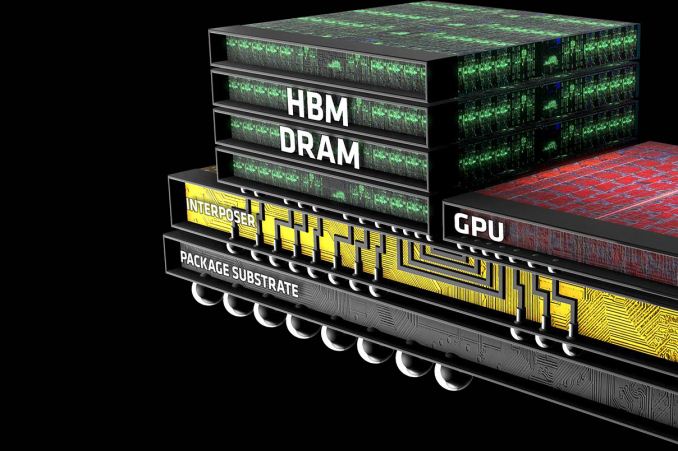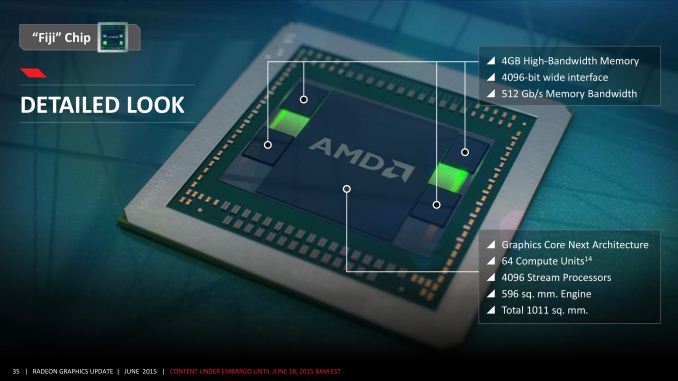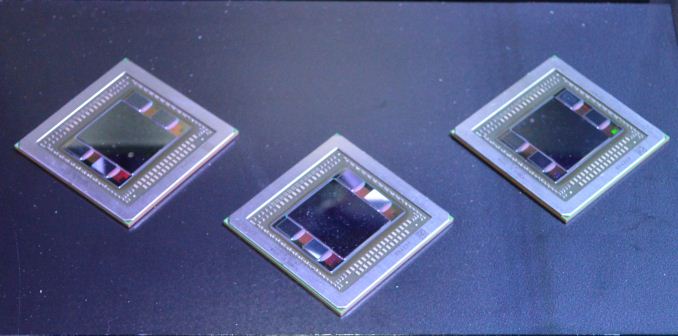The AMD Radeon R9 Fury X Review: Aiming For the Top
by Ryan Smith on July 2, 2015 11:15 AM ESTThe Fiji GPU: Go Big or Go Home
Now that we’ve had a chance to take a look at the architecture backing Fiji, let’s talk about the Fiji GPU itself.
Fiji’s inclusion of High Bandwidth Memory (HBM) technology complicates the picture somewhat when talking about GPUs. Whereas past GPUs were defined by the GPU die itself and then the organic substrate package it sits on, the inclusion of HBM requires a third layer, the silicon interposer. The job of the interposer is to sit between the package and the GPU, serving as the layer that connects the on-package HBM memory stacks with the GPU. Essentially a very large chip without any expensive logic on it, the silicon interposer allows for finer, denser signal routing than organic packaging is capable of, making the ultra-wide 4096-bit HBM bus viable for the first time.
We’ll get to HBM in detail in a bit, but it’s important to call out the impact of HBM and the interposer early, since they have a distinct impact on how Fiji was designed and what its capabilities are.
As for Fiji itself, Fiji is unlike any GPU built before by AMD, and not only due to the use of HBM. More than anything else, it’s simply huge, 596mm2 to be precise. As we mentioned in our introduction, AMD has traditionally shied away from big chips, even after the “small die” era ended, and for good reason. Big chips are expensive to develop, expensive to produce, take longer to develop, and yield worse than small chips (this being especially the case early-on for 40nm). Altogether they’re riskier than smaller chips, and while there are times where they are necessary, AMD has never reached this point until now.
The end result is that for the first time since the unified shader era began, AMD has gone toe-to-toe with NVIDIA on die size. Fiji’s 596mm2 die size is just 5mm2 (<1%) smaller than NVIDIA’s GM200, and more notably still hits TSMC’s 28nm reticle limit. TSMC can’t build chips any bigger than this; Fiji is as big a chip as AMD can order.
| AMD Big GPUs | ||||
| Die Size | Native FP64 Rate | |||
| Fiji (GCN 1.2) | 596mm2 | 1/16 | ||
| Hawaii (GCN 1.1) | 438mm2 | 1/2 | ||
| Tahiti (GCN 1.0) | 352mm2 | 1/4 | ||
| Cayman (VLIW4) | 389mm2 | 1/4 | ||
| Cypress (VLIW5) | 334mm2 | 1/5 | ||
| RV790 (VLIW5) | 282mm2 | N/A | ||
Looking at Fiji relative to AMD’s other big GPUs, it becomes very clear very quickly just how significant this change is for AMD. When Hawaii was released in 2013 at 438mm2, it was already AMD’s biggest GPU ever for its time. And yet Fiji dwarfs it, coming in at 158mm2 (36%) larger. The fact that Fiji comes at the latter-half of the 28nm process’s life time means that such a large GPU is not nearly as risky now as it would have been in 2011/2012 (NVIDIA surely took some licks internally on GK110), but still, nothing else we can show you today can really sell the significance of Fiji to AMD as much as the die size can.
And the fun doesn’t stop there. Along with producing the biggest die they could, AMD has also more or less gone the direction of NVIDIA and Maxwell in the case of Fiji, building what is unambiguously the most gaming/FP32-centric GPU the company could build. With GCN supporting power-of-two FP64 rates between 1/2 and 1/16, AMD has gone for the bare minimum in FP64 performance that their architecture allows, leading to a 1/16 FP64 rate on Fiji. This is a significant departure from Hawaii, which implemented native support for ½ rate, and on consumer parts offered a handicapped 1/8 rate. Fiji will not be a FP64 powerhouse – its 4GB of VRAM is already perhaps too large of a handicap for the HPC market – so instead we get AMD’s best FP32 GPU going against NVIDIA’s best FP32 GPU.
AMD’s final ace up their sleeve on die size is HBM. Along with HBM’s bandwidth and power benefits, HBM is also much simpler to implement, requiring less GPU space for PHYs than GDDR5 does. This is in part due to the fact that HBM stacks have their own logic layer, distributing some of the logic on to each stack, and furthermore a benefit of the fact that the signaling logic that remains doesn’t have to be nearly as complex since the frequencies are so much lower. 4096-bits of HBM PHYs still takes up a fair bit of space – though AMD won’t tell us how much – but it’s notably lower than the amount of space AMD was losing to Hawaii’s GDDR5 memory controllers.
The end result is that not only has AMD built their biggest GPU ever, but they have done virtually everything they can to maximize the amount of die space they get to allocate to FP32 and rendering resources. Simply put, AMD has never reached so high and aimed for parity with NVIDIA in this manner.
Ultimately this puts Fiji’s transistor count at 8.9 billion transistors, even more than the 8 billion transistors found in NVIDIA’s GM200, and, as expected, significantly more than Hawaii’s 6.2 billion. Interestingly enough, on a relative basis this is almost exactly the same increase we saw with Hawaii; Fiji packs in 43.5% more transistors than Hawaii, and Hawaii packed in 43.9% more transistors than Tahiti. So going by transistors alone, Fiji is very much to Hawaii what Hawaii was to Tahiti.
Finally, as large as the Fiji GPU is, the silicon interposer it sits on is even larger. The interposer measures 1011mm2, nearly twice the size of Fiji. Since Fiji and its HBM stacks need to fit on top of it, the interposer must be very large to do its job, and in the process it pushes its own limits. The actual interposer die is believed to exceed the reticle limit of the 65nm process AMD is using to have it built, and as a result the interposer is carefully constructed so that only the areas that need connectivity receive metal layers. This allows AMD to put down such a large interposer without actually needing a fab capable of reaching such a large reticle limit.
What’s interesting from a design perspective is that the interposer and everything on it is essentially the heart and soul of the GPU. There is plenty of power regulation circuitry on the organic package and even more on the board itself, but within the 1011mm2 floorplan of the interposer, all of Fiji’s logic and memory is located. By mobile standards it’s very nearly an SoC in and of itself; it needs little more than external power and I/O to operate.













458 Comments
View All Comments
TallestJon96 - Sunday, July 5, 2015 - link
This card and the 980 ti meet two interesting milestones in my mind. First, this is the first time 1080p isn't even considered. Pretty cool to be at the point where 1080p is considered at bit of a low resolution for high end cards.Second, it's the point where we have single cards can play games at 4k, with higher graphical settings, and have better performance than a ps4. So at this point, if a ps4 is playable, than 4k gaming is playable.
It's great to see higher and higher resolutions.
XtAzY - Sunday, July 5, 2015 - link
Geez these benchies are making my 580 looking ancient.MacGyver85 - Sunday, July 5, 2015 - link
Idle power does not start things off especially well for the R9 Fury X, though it’s not too poor either. The 82W at the wall is a distinct increase over NVIDIA’s latest cards, and even the R9 290X. On the other hand the R9 Fury X has to run a CLLC rather than simple fans. Further complicating factors is the fact that the card idles at 300MHz for the core, but the memory doesn’t idle at all. HBM is meant to have rather low power consumption under load versus GDDR5, but one wonders just how that compares at idle.I'd like to see you guys post power consumption numbers with power to the pump cut at idle, to answer the questions you pose. I'm pretty sure the card is competitive without the pump running (but still with the fan to have an equal comparison). If not it will give us more of an insight in what improvements AMD can give to HBM in the future with regards to power consumption. But I'd be very suprised if they haven't dealt with that during the design phase. After all, power consumption is THE defining limit for graphics performance.
Oxford Guy - Sunday, July 5, 2015 - link
Idle power consumption isn't the defining limit. The article already said that the cooler keeps the temperature low while also keeping noise levels in check. The result of keeping the temperature low is that AMD can more aggressively tune for performance per watt.Oxford Guy - Sunday, July 5, 2015 - link
This is a gaming card, not a card for casuals who spend most of their time with the GPU idling.Oxford Guy - Sunday, July 5, 2015 - link
The other point which wasn't really made in the article is that the idle noise is higher but consider how many GPUs exhaust their heat into the case. That means higher case fan noise which could cancel out the idle noise difference. This card's radiator can be set to exhaust directly out of the case.mdriftmeyer - Sunday, July 5, 2015 - link
It's an engineering card as much as it is for gaming. It's a great solid modeling card with OpenCL. The way AMD is building its driver foundation will pay off big in the next quarter.Nagorak - Monday, July 6, 2015 - link
I don't know that I agree about that. Even people who game a lot probably use their computer for other things and it sucks to be using more watts while idle. That being said, the increase is not a whole lot.Oxford Guy - Thursday, July 9, 2015 - link
Gaming is a luxury activity. People who are really concerned about power usage would, at the very least, stick with a low-wattage GPU like a 750 Ti or something and turn down the quality settings. Or, if you really want to be green, don't do 3D gaming at all.MacGyver85 - Wednesday, July 15, 2015 - link
That's not really true. I don't mind my gfx card pulling a lot of power while I'm gaming. But I want it to sip power when it's doing nothing. And since any card spends most of its time idling, idling is actually very important (if not most important) in overal (yearly) power consumption.Btw I never said that idle power consumption is the defining limit, I said power consumption is the defining limit. It's a give that any Watt you save while idling is generally a Watt of extra headroom when running at full power. The lower the baseline load the more room for actual, functional (graphics) power consumption. And as it turns out I was right in my assumption that the actual graphics card minus the cooler pump idle power consumption is competitive with nVidia's.